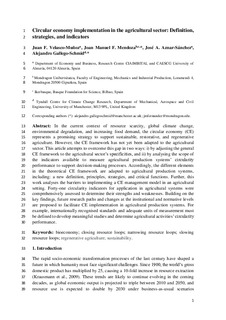Título
Circular economy implementation in the agricultural sector: Definition, strategies and indicatorsAutor-a
Autor-a (de otra institución)
Otras instituciones
University of ManchesterUniversidad de Almería
Ikerbasque
Versión
Preprint en revisión
Derechos
© 2021 Elsevier B.V.Acceso
Acceso embargadoVersión del editor
https://doi.org/10.1016/j.resconrec.2021.105618Publicado en
Resources conservation and recycling. Vol. 170. N. artículo. 170, 2021Editor
Elsevier B.V.Palabras clave
Bioeconomy
Closing resource loops
Narrowing resource loops
Slowing resource loops ... [+]
Closing resource loops
Narrowing resource loops
Slowing resource loops ... [+]
Bioeconomy
Closing resource loops
Narrowing resource loops
Slowing resource loops
Regenerative agriculture
sustainability [-]
Closing resource loops
Narrowing resource loops
Slowing resource loops
Regenerative agriculture
sustainability [-]
Resumen
In the current context of resource scarcity, global climate change, environmental degradation, and increasing food demand, the circular economy (CE) represents a promising strategy for supporting sust ... [+]
In the current context of resource scarcity, global climate change, environmental degradation, and increasing food demand, the circular economy (CE) represents a promising strategy for supporting sustainable, restorative, and regenerative agriculture. A review of the literature on CE confirms the initial hypothesis that the theoretical CE framework has not yet been adapted to the field of agriculture. Therefore, this paper overcomes this gap in two ways: i) by adjusting the general CE framework to the agricultural sector's specificities, and ii) by analyzing the scope of the indicators available for measuring agricultural production systems’ circularity performance in supporting decision-making processes. Accordingly, the different elements in the theoretical CE framework are adapted to agricultural production systems. One major contribution of this paper is the definition of CE applied to agriculture. In addition, the principles of CE are adapted to the field, and CE strategies for agricultural activity are defined. Forty-one circularity indicators for application in agricultural systems were also comprehensively assessed to determine their strengths and weaknesses. Building on the key findings, future research paths and changes at the institutional and normative levels are proposed to facilitate CE implementation in agricultural production systems. For example, internationally recognized standards and adequate units of measurement must be defined, to develop meaningful studies and determine agricultural activities’ circularity performance. [-]
Sponsorship
Gobierno de EspañaID Proyecto
GE/Programa estatal de Fomento de la Investigación Científica y Técnica de Excelencia, Subprograma estatal de generación del conocimiento, en el marco del Plan estatal de Investigación Científica y Técnica y de Innovación 2013-2016. Convocatoria 2017/ECO 2017-82347-P/ES/Internacionalización económica y sostenibilidad. Determinantes de la eco-innovación y la heterogeneidad en productividad y rendimiento medioambiental/Colecciones
- Artículos - Ingeniería [683]






















